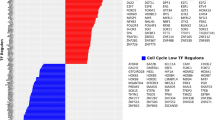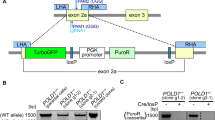Abstract
Although activating mutations of PIK3CA are frequent in urothelial carcinoma (UC), no information is available on their specific effects in urothelial cells or the basis for the observed mutation spectrum, which has a large excess of helical domain mutations. We investigated the phenotypic and signaling consequences of hotspot and UC-specific rare PIK3CA mutations in immortalized normal human urothelial cells (NHUC) and mouse fibroblasts (NIH3T3). Our results indicate that in NHUC, rare mutant forms and all three hotspot mutant forms of PIK3CA can activate the PI3K/AKT pathway. The relative frequency at which helical domain and kinase domain mutations are found in UC is related to their potency in inducing signaling downstream of AKT and to the phenotypic effects induced in this cell type (E545K>E542K>H1047R). Helical domain mutations E542K and E545K conferred a significant proliferative advantage at confluence and under conditions of nutrient depletion, and increased cellular resistance to anoikis. Both helical and kinase domain mutants induced increased NHUC cell motility and migration towards a chemoattractant, though no significant differences were found between the mutant forms. In NIH3T3 cells, the kinase domain mutant H1047R induced high levels of AKT activation, but helical domain mutants were significantly less potent and this was reflected in their relative abilities to confer anchorage-independent growth. Our findings indicate that the effects of mutant PIK3CA are both cell type- and mutation-specific. Helical domain mutations in PIK3CA may confer a selective advantage in the urothelium in vivo by overcoming normal contact-mediated inhibitory signals and allowing proliferation in nutrient-limiting conditions. Mutant forms of PIK3CA may also stimulate intraepithelial cell movement, which could contribute to spread of cells within the urothelium.
This is a preview of subscription content, access via your institution
Access options
Subscribe to this journal
Receive 50 print issues and online access
$259.00 per year
only $5.18 per issue
Buy this article
- Purchase on Springer Link
- Instant access to full article PDF
Prices may be subject to local taxes which are calculated during checkout




Similar content being viewed by others
References
Samuels Y, Ericson K . Oncogenic PI3K and its role in cancer. Curr Opin Oncol 2006; 18: 77–82.
Jaiswal BS, Janakiraman V, Kljavin NM, Chaudhuri S, Stern HM, Wang W et al. Somatic mutations in p85alpha promote tumorigenesis through class IA PI3K activation. Cancer Cell 2009; 16: 463–474.
Bachman KE, Argani P, Samuels Y, Silliman N, Ptak J, Szabo S et al. The PIK3CA gene is mutated with high frequency in human breast cancers. Cancer Biol Ther 2004; 3: 772–775.
Samuels Y, Wang Z, Bardelli A, Silliman N, Ptak J, Szabo S et al. High frequency of mutations of the PIK3CA gene in human cancers. Science 2004; 304: 554.
Broderick DK, Di C, Parrett TJ, Samuels YR, Cummins JM, McLendon RE et al. Mutations of PIK3CA in anaplastic oligodendrogliomas, high-grade astrocytomas, and medulloblastomas. Cancer Res 2004; 64: 5048–5050.
Campbell IG, Russell SE, Choong DY, Montgomery KG, Ciavarella ML, Hooi CS et al. Mutation of the PIK3CA gene in ovarian and breast cancer. Cancer Res 2004; 64: 7678–7681.
Lopez-Knowles E, Hernandez S, Malats N, Kogevinas M, Lloreta J, Carrato A et al. PIK3CA mutations are an early genetic alteration associated with FGFR3 mutations in superficial papillary bladder tumors. Cancer Res 2006; 66: 7401–7404.
Platt FM, Hurst CD, Taylor CF, Gregory WM, Harnden P, Knowles MA . Spectrum of phosphatidylinositol 3-kinase pathway gene alterations in bladder cancer. Clin Cancer Res 2009; 15: 6008–6017.
Kompier LC, Lurkin I, van der Aa MN, van Rhijn BW, van der Kwast TH, Zwarthoff EC . FGFR3, HRAS, KRAS, NRAS and PIK3CA mutations in bladder cancer and their potential as biomarkers for surveillance and therapy. PloS One 2010; 5: e13821.
Sjodahl G, Lauss M, Gudjonsson S, Liedberg F, Hallden C, Chebil G et al. A systematic study of gene mutations in urothelial carcinoma; inactivating mutations in TSC2 and PIK3R1. PloS One 2011; 6: e18583.
Gymnopoulos M, Elsliger MA, Vogt PK . Rare cancer-specific mutations in PIK3CA show gain of function. Proc Natl Acad Sci USA 2007; 104: 5569–5574.
Zhang H, Liu G, Dziubinski M, Yang Z, Ethier SP, Wu G . Comprehensive analysis of oncogenic effects of PIK3CA mutations in human mammary epithelial cells. Breast Cancer Res Treat 2007; 112: 217–227.
Ikenoue T, Kanai F, Hikiba Y, Obata T, Tanaka Y, Imamura J et al. Functional analysis of PIK3CA gene mutations in human colorectal cancer. Cancer Res 2005; 65: 4562–4567.
Samuels Y, Diaz Jr LA, Schmidt-Kittler O, Cummins JM, Delong L, Cheong I et al. Mutant PIK3CA promotes cell growth and invasion of human cancer cells. Cancer Cell 2005; 7: 561–573.
Huang CH, Mandelker D, Schmidt-Kittler O, Samuels Y, Velculescu VE, Kinzler KW et al. The structure of a human p110alpha/p85alpha complex elucidates the effects of oncogenic PI3Kalpha mutations. Science 2007; 318: 1744–1748.
Knowles MA . Molecular subtypes of bladder cancer: Jekyll and Hyde or chalk and cheese? Carcinogenesis 2006; 27: 361–373.
Zhao L, Vogt PK . Helical domain and kinase domain mutations in p110alpha of phosphatidylinositol 3-kinase induce gain of function by different mechanisms. Proc Natl Acad Sci USA 2008; 105: 2652–2657.
Zhao JJ, Liu Z, Wang L, Shin E, Loda MF, Roberts TM . The oncogenic properties of mutant p110alpha and p110beta phosphatidylinositol 3-kinases in human mammary epithelial cells. Proc Natl Acad Sci USA 2005; 102: 18443–18448.
Soule HD, Maloney TM, Wolman SR, Peterson Jr WD, Brenz R, McGrath CM et al. Isolation and characterization of a spontaneously immortalized human breast epithelial cell line, MCF-10. Cancer Res 1990; 50: 6075–6086.
Murugan AK, Hong NT, Fukui Y, Munirajan AK, Tsuchida N . Oncogenic mutations of the PIK3CA gene in head and neck squamous cell carcinomas. Int J Oncol 2008; 32: 101–111.
Isakoff SJ, Engelman JA, Irie HY, Luo J, Brachmann SM, Pearline RV et al. Breast cancer-associated PIK3CA mutations are oncogenic in mammary epithelial cells. Cancer Res 2005; 65: 10992–11000.
Gustin JP, Karakas B, Weiss MB, Abukhdeir AM, Lauring J, Garay JP et al. Knockin of mutant PIK3CA activates multiple oncogenic pathways. Proc Natl Acad Sci USA 2009; 106: 2835–2840.
Chapman EJ, Hurst CD, Pitt E, Chambers P, Aveyard JS, Knowles MA . Expression of hTERT immortalises normal human urothelial cells without inactivation of the p16/Rb pathway. Oncogene 2006; 25: 5037–5045.
Sun M, Wang G, Paciga JE, Feldman RI, Yuan ZQ, Ma XL et al. AKT1/PKBalpha kinase is frequently elevated in human cancers and its constitutive activation is required for oncogenic transformation in NIH3T3 cells. Am J Pathol 2001; 159: 431–437.
Askham JM, Platt F, Chambers PA, Snowden H, Taylor CF, Knowles MA . AKT1 mutations in bladder cancer: identification of a novel oncogenic mutation that can co-operate with E17K. Oncogene 2009; 29: 150–155.
Yu J, Zhang Y, McIlroy J, Rordorf-Nikolic T, Orr GA, Backer JM . Regulation of the p85/p110 phosphatidylinositol 3′-kinase: stabilization and inhibition of the p110alpha catalytic subunit by the p85 regulatory subunit. Mol Cell Biol 1998; 18: 1379–1387.
Fu Z, Aronoff-Spencer E, Backer JM, Gerfen GJ . The structure of the inter-SH2 domain of class IA phosphoinositide 3-kinase determined by site-directed spin labeling EPR and homology modeling. Proc Natl Acad Sci USA 2003; 100: 3275–3280.
Shekar SC, Wu H, Fu Z, Yip SC, Nagajyothi, Cahill SM et al. Mechanism of constitutive phosphoinositide 3-kinase activation by oncogenic mutants of the p85 regulatory subunit. J Biol Chem 2005; 280: 27850–27855.
Mandelker D, Gabelli SB, Schmidt-Kittler O, Zhu J, Cheong I, Huang CH et al. A frequent kinase domain mutation that changes the interaction between PI3Kalpha and the membrane. Proc Natl Acad Sci USA 2009; 106: 16996–17001.
Cain RJ, Ridley AJ . Phosphoinositide 3-kinases in cell migration. Biol Cell 2009; 101: 13–29.
Wu X, Obata T, Khan Q, Highshaw RA, De Vere White R, Sweeney C . The phosphatidylinositol-3 kinase pathway regulates bladder cancer cell invasion. BJU Int 2004; 93: 143–150.
Theodorescu D, Laderoute KR, Gulding KM . Epidermal growth factor receptor-regulated human bladder cancer motility is in part a phosphatidylinositol 3-kinase-mediated process. Cell Growth Differ 1998; 9: 919–928.
Rieger-Christ KM, Lee P, Zagha R, Kosakowski M, Moinzadeh A, Stoffel J et al. Novel expression of N-cadherin elicits in vitro bladder cell invasion via the Akt signaling pathway. Oncogene 2004; 23: 4745–4753.
Rieger-Christ KM, Hanley R, Lodowsky C, Bernier T, Vemulapalli P, Roth M et al. The green tea compound, (−)-epigallocatechin-3-gallate downregulates N-cadherin and suppresses migration of bladder carcinoma cells. J Cell Biochem 2007; 102: 377–388.
Pang H, Flinn R, Patsialou A, Wyckoff J, Roussos ET, Wu H et al. Differential enhancement of breast cancer cell motility and metastasis by helical and kinase domain mutations of class IA phosphoinositide 3-kinase. Cancer Res 2009; 23: 8868–8876.
Guo XN, Rajput A, Rose R, Hauser J, Beko A, Kuropatwinski K et al. Mutant PIK3CA-bearing colon cancer cells display increased metastasis in an orthotopic model. Cancer Res 2007; 67: 5851–5858.
Carson JD, Van Aller G, Lehr R, Sinnamon RH, Kirkpatrick RB, Auger KR et al. Effects of oncogenic p110alpha subunit mutations on the lipid kinase activity of phosphoinositide 3-kinase. Biochem J 2008; 409: 519–524.
Chaussade C, Cho K, Mawson C, Rewcastle GW, Shepherd PR . Functional differences between two classes of oncogenic mutation in the PIK3CA gene. Biochem Biophys Res Commun 2009; 381: 577–581.
di Martino E, L’Hote CG, Kennedy W, Tomlinson DC, Knowles MA . Mutant fibroblast growth factor receptor 3 induces intracellular signaling and cellular transformation in a cell type- and mutation-specific manner. Oncogene 2009; 28: 4306–4316.
Shin JJ, Katayama T, Michaud WA, Rocco JW . Short hairpin RNA system to inhibit human p16 in squamous cell carcinoma. Arch Otolaryngol Head Neck Surg 2004; 130: 68–73.
Tomlinson DC, Hurst CD, Knowles MA . Knockdown by shRNA identifies S249C mutant FGFR3 as a potential therapeutic target in bladder cancer. Oncogene 2007; 26: 5889–5899.
Tomlinson DC, Baldo O, Harnden P, Knowles MA . FGFR3 protein expression and its relationship to mutation status and prognostic variables in bladder cancer. J Pathol 2007; 213: 91–98.
Guex N, Peitsch MC . SWISS-MODEL and the Swiss-PdbViewer: an environment for comparative protein modeling. Electrophoresis 1997; 18: 2714–2723.
Acknowledgements
This work was funded by a PhD studentship from the Medical Research Council, awarded via the University of Leeds.
Author information
Authors and Affiliations
Corresponding author
Ethics declarations
Competing interests
The authors declare no conflict of interest.
Additional information
Supplementary Information accompanies the paper on the Oncogene website
Supplementary information
Rights and permissions
About this article
Cite this article
Ross, R., Askham, J. & Knowles, M. PIK3CA mutation spectrum in urothelial carcinoma reflects cell context-dependent signaling and phenotypic outputs. Oncogene 32, 768–776 (2013). https://doi.org/10.1038/onc.2012.87
Received:
Revised:
Accepted:
Published:
Issue Date:
DOI: https://doi.org/10.1038/onc.2012.87
Keywords
This article is cited by
-
APOBEC3-mediated mutagenesis in cancer: causes, clinical significance and therapeutic potential
Journal of Hematology & Oncology (2023)
-
Dysregulation at multiple points of the kynurenine pathway is a ubiquitous feature of renal cancer: implications for tumour immune evasion
British Journal of Cancer (2020)
-
Mutation site and context dependent effects of ESR1 mutation in genome-edited breast cancer cell models
Breast Cancer Research (2017)
-
PIK3CA dependence and sensitivity to therapeutic targeting in urothelial carcinoma
BMC Cancer (2016)
-
AKT1 E17K mutation profiling in breast cancer: prevalence, concurrent oncogenic alterations, and blood-based detection
BMC Cancer (2016)



